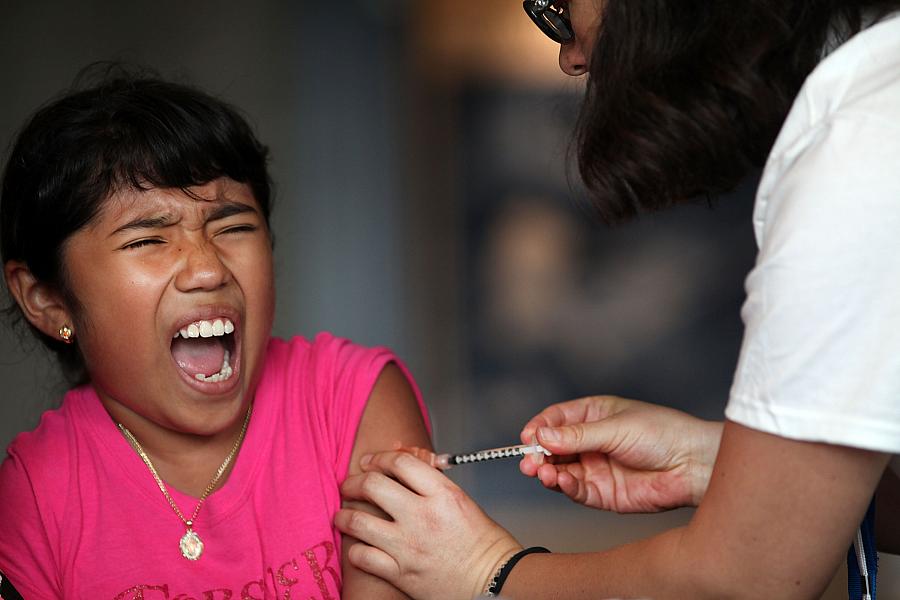As CHIP funding deadline looms, here’s what reporters should know

Ariana Pedraza (10) gets a shot by a nurse at the Yankees / Lincoln Hospital Back-to-School Immunization Fair on September 1, 2015 in New York City. The annual health fair offered free vaccinations to protect children for the long term against diseases such as tetanus, diphtheria, whooping cough, and hepatitis. Children also received a free Yankee ticket. (Photo by Spencer Platt/Getty Images)
A year and a half ago, everything was going well for the Jacob family.
Natasha Jacob was employed as a part-time kindergarten teacher and her husband John as a manager in a startup. The family – including their son Eliott, now 8—received health insurance through John’s job.
But when John’s company was unexpectedly bought out, he not only lost his job but also his family’s insurance. The couple turned to Covered California for themselves and Medi-Cal for their son. They qualified under the Children’s Health Insurance Program (CHIP), which includes families who make too much money to qualify for regular Medi-Cal (up to 266 percent of the federal poverty line).
“We’re just ordinary people with an unfortunate experience,” said Natasha Jacob, who teaches in Northern California’s San Leandro Unified School District. “This is exactly why these things are available.”
As the deadline looms for CHIP’s funding renewal, there’s been a flurry of media pieces pointing to the Sept. 30 expiration date – and the ticking clock. But, with historic bipartisan support, is this federally-funded program – which provides coverage to about 9 million children nationwide—really in jeopardy?
Hopefully not, said Mike Odeh of Children Now, a children’s advocacy group. Congress has historically come through and funded CHIP. But that doesn’t mean reporters should ignore the issue, Odeh and other children’s health advocates say.
With all of the items on the docket - including Hurricane Harvey emergency aid - some advocates worry the CHIP measure could take a back seat. That could lead to a messy situation for states that need to plan out their budgets and solidify contracts with care organizations. A congressional advisory group estimates a few states would run out of CHIP funding by the end of the year, and dozens more in the early months of 2018.
It isn’t enough to know the check is in the mail, says Alison Buist of the Children’s Defense Fund: “States need the law to be passed and the money to be flowing.”
With its strong bipartisan support, CHIP supporters say they’re optimistic that the program’s renewal won’t get caught up in the past year’s health reform debate. That said, they stressed the importance of preserving Medicaid’s long-term viability.
“CHIP sits on the shoulders of Medicaid, so it’s very important to ensure strong Medicaid to ensure CHIP is working properly,” Buist said. “Ensuring Medicaid is protected from structural changes is just foundational for CHIP.”
Seeking a Longer Window
In 2015, CHIP was not only renewed but it got a significant bump in its federal matching rate, something that varies by state. For example, California’s federal match rate rose from 65 to 88 percent. That bump lasts until 2019. (For examples of what states have done with the funding bump, check out this post from the Georgetown University Health Policy Institute).
At the time, Congress extended CHIP funds for two years. While it’s great the funds came through, program advocates say they’d like to see a longer window this time around.
“By having short-term authorizations, it doesn’t allow states to innovate or do anything interesting,” Buist said.
Those include quality initiatives to measure immunization rates, well child visits and developmental screening, allowing for a nationwide comparison, Odeh added.
“It would be a shame if some of those initiatives lost some of the wind in their sails,” he said. “The program needs to be strong and stable to focus on improving quality.”
Health Coverage Matters
Together, with Medicaid and the Affordable Care Act, CHIP has helped bring the national coverage rate for children to 95 percent.
Ensuring that children receive health coverage is something that has a tremendous impact on their lives, Buist said. From their ability to perform in school to their incomes later in life, health coverage matters.
“We are hopeful that we will continue to move forward towards coverage for all children, but, at a minimum, no child should lose ground,” Buist said.
As for Jacob, the East Bay kindergarten teacher, CHIP - and Covered California - gave her family a safety net while they figured out their next steps. Now, her husband has launched his own software development company, and she’s working full-time as a teacher.
“It got us through that one year when we were really short on money,” she said.
That experience isn’t unusual, said Janis Lambert Connallon of the Children’s Defense Fund - California.
“Her story is pretty typical of working families who need a little extra help until they can get back on their feet and get private insurance,” she said.

